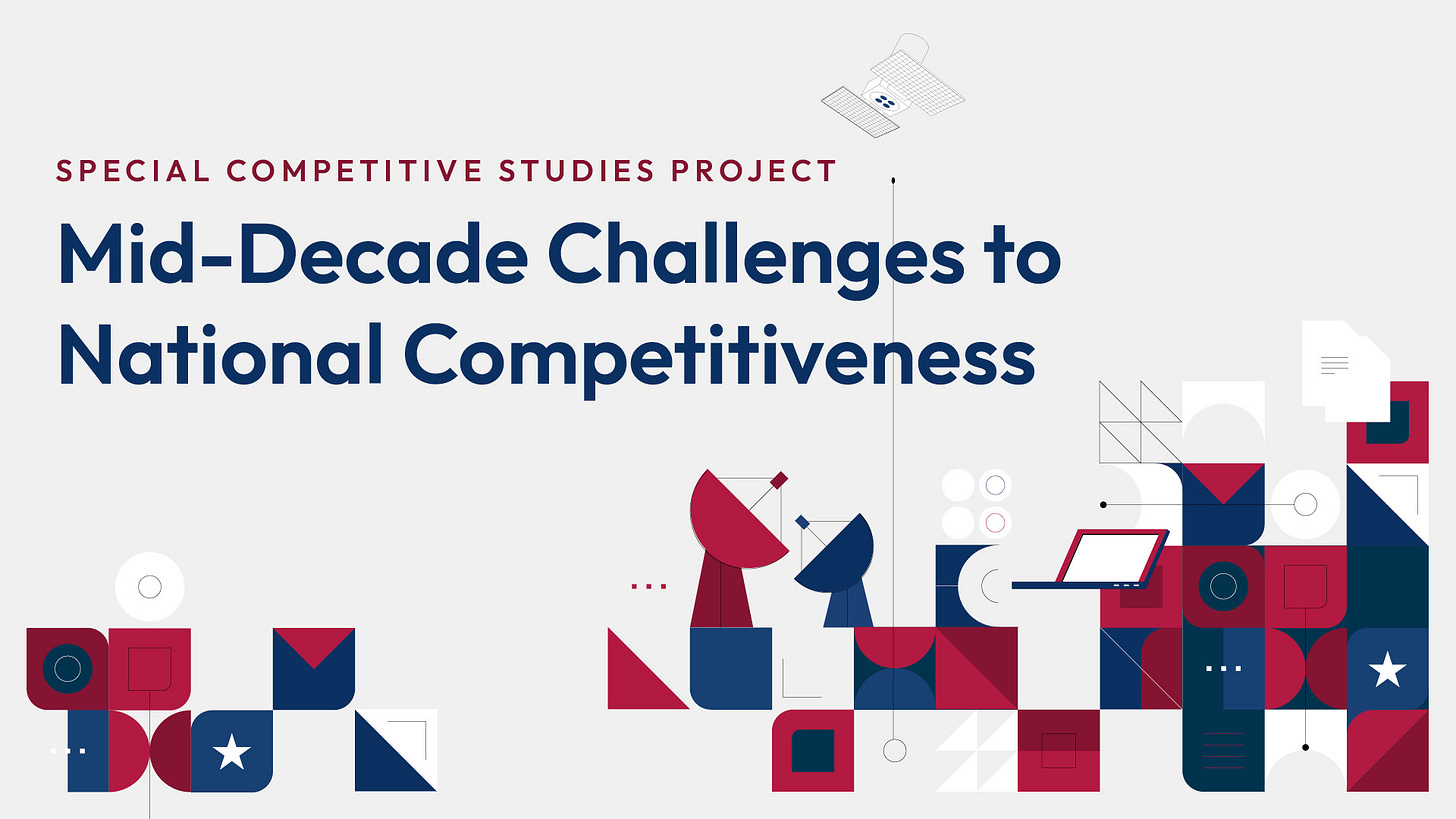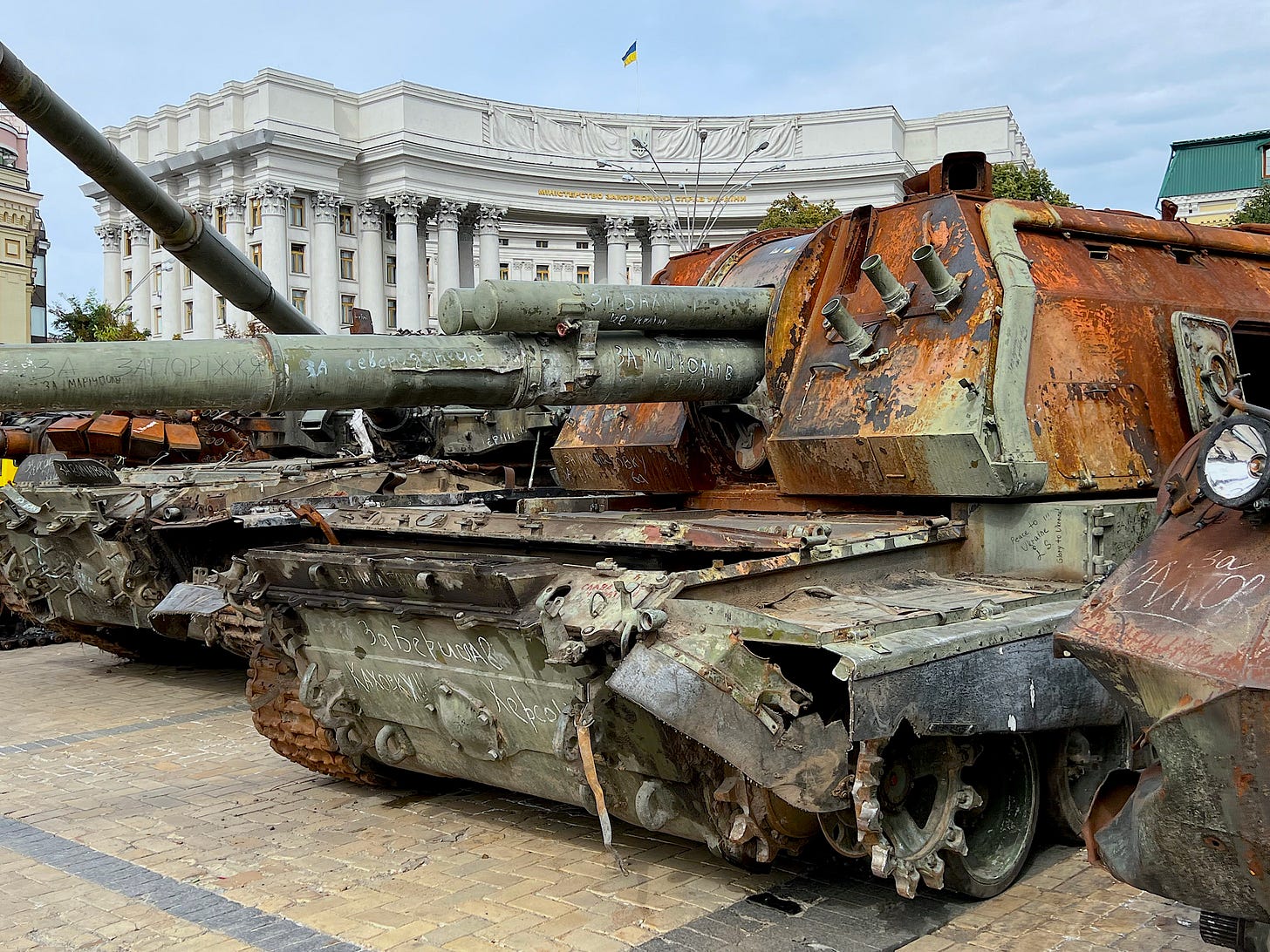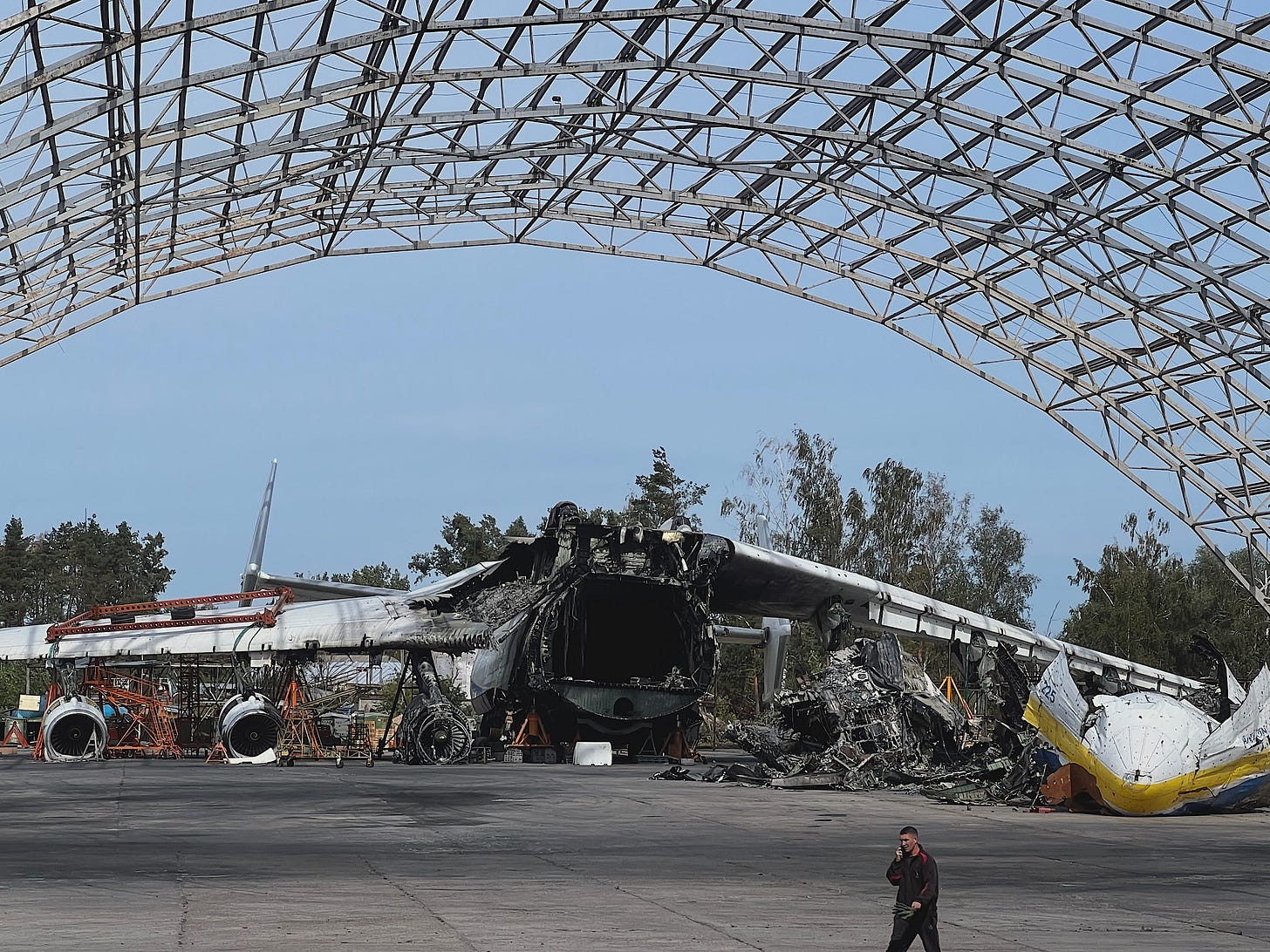The First Networked War: Eric Schmidt’s Ukraine Trip Report
SCSP’s First Report and Global Emerging Technology Summit
Hello, I'm Ylli Bajraktari, CEO of the Special Competitive Studies Project. In this month's edition of our newsletter, we issue our initial SCSP report, share a trip report from a visit to Ukraine by our Chair, Dr. Eric Schmidt, and post final details about our September 16th Global Emerging Technology Summit.
SCSP’s First Report
We are excited to share our first report, Mid-Decade Challenges to National Competitiveness!
The report outlines the stakes of the U.S.-China technology competition and presents an agenda to strengthen U.S. competitiveness. It elevates issues that merit the nation’s attention to ensure we improve the U.S. position by 2025, and identifies the technology areas where we must act by 2030 to retain our advantage. The report is our initial why and what that outlines our logic for action today to prepare for tomorrow.
You can view the report by clicking the report title above or visiting our website.
Reach out to info@scsp.ai with any questions!
The First Networked War: Eric Schmidt’s Ukraine Trip Report
The following is a personal account from Eric Schmidt’s September 2022 trip to Ukraine.
Ukraine displays destroyed Russian tanks in Kyiv city center. (photo by E. Schmidt)
The first thing you notice about Ukraine, and its capital Kyiv in war, is how normal everything is. Aside from the damage from the February attacks, the city appears to be operating normally. Cars fill the streets, men, women and children dressed casually linger, eat out, and generally love their city. One could see stylish people, good food, nice restaurants, and importantly to me – a reliable LTE cellular network. Even Uber is running. What a difference six months makes!
You get to Ukraine through Poland (all airports in Ukraine are closed) and take the train to the capital. The blacked-out train was a brand new one built in Ukraine this year with a Starlink terminal on it, delivering 130MB to passengers even while in motion. Imagine this for Amtrak! The train takes about 11 hours, and involves old engine and track changes dating from before World War II.
The city is truly beautiful, with Ukrainian churches adorned in the most beautiful ways. Sandbagged monuments to fallen heroes are on street corners and wounded veterans stand out in the crowd. Traffic jams are routine, and life goes on as in every European capital, until 11PM when quiet descends due to a curfew.
A visit to the government headquarters and the military suggests all is normal, except when it is not. The government feels like a war government, with sandbags everywhere and a sense of purpose that is remarkable. During my visit a Ukrainian counteroffensive resulted in 2,500 square kilometers being liberated from Russian occupation. The feeling in Kyiv is one of optimism, that the new strategy, weapons, and approaches have turned the war. It's clear that the Ukrainians will not engage in negotiations right now and that they want the 25% of their country back.
War is truly hell, and the pictures were on display everywhere to show it. We toured Bucha (the site of reported war crimes committed by Russian soldiers during their initial attempts to seize Kyiv in February/March) and the local airport where the Antonov An-225 - the largest airplane ever built - was destroyed. I can’t imagine what the first week of invasion in late February was like. The public narrative suggests that Ukraine has a 90-day plan for winning in the fall, and they believe the Russians are waiting for the dead of winter for the West to lose interest. So time matters.
Wreckage of the destroyed Antonov An-225 – the world’s largest plane – at the Antonov International Airport in Hostomel, Ukraine (photo by E. Schmidt)
Ukraine has a long history of independence and occupation. The view on the ground is that before the war, a new leadership in Ukraine was established that was not from Soviet times, and that they are younger (much younger) and more modern in thinking than their predecessors. The new President, Volodymyr Zelensky, brought in a new team, challenged the internal elites, and has changed the country in profound ways. Zelensky is personally very impressive, highly intelligent, and I’m told has changed a great deal as a result of the war. His clarity, messaging, and certainty is literally thrilling to his citizens. You can tell their leaders come from television: they know appearances matter. They're all in battle fatigues all the time. They sleep and workout together. It's a very tight-knit leadership structure.


Today, the reputation for corruption in Ukraine is answered by a simple fact: the transfer fees from Russian energy going to Europe, which was essentially free money and a source of government corruption, is about to be gone. The entrepreneurship and character of the Ukrainian people gives an opportunity for a real change in how their nation, and government, will operate post-war.
Ukraine has some very, very serious problems amidst the optimism. Their government revenues have declined by a third, and they have to pay for the war and eventual recovery. Inflation and interest rates are well above 20%. While some displaced Ukrainians have returned, they desperately need the remaining 6.7 million of their citizens to return to the country (Poland has been a particularly helpful ally, hosting millions of refugees and doing so without putting them into resettlement camps). Martial law remains in place. While the UK and United States have been very helpful, the view on the ground is that EU funds, and particularly German help, has been very slow. Ideally the EU and the IMF would move quickly to match multi-billion dollar/euro assistance packages and loans; time matters. The Ukrainians are requesting more weapons in the form of more “tubes” (presumably HIMARS), more tanks, more airplanes, and the underlying technology to upgrade what they have from Soviet times.
For me, the war answers a central question: what can technology people do to help their government, and the answer is a lot. The adoption of Starlink very early had a huge impact (now 20,000 terminals in the country and the Starlink was faster than the fiber to our hotel). Heavy cyberattacks were repelled successfully and an active campaign against misinformation has worked. Even before the war, Ukraine had built a system called Diia as an e-government solution similar to that in Estonia but more capable. Diia uses a government biometric database to authenticate the phone user, and once authenticated most government services and banking services work well including passport, drivers license, and taxes. This platform became crucial for the war as menus were added to report important war targets and also casualties. The app calls an encrypted messaging service to pass along the information to the military along with pictures that are scanned automatically by the military looking for targets they care about. A separate group engages in active disinformation against the other side. Ukrainian hackers “improved” the Soviet and western systems to be more capable and more accurate than the designers and builders intended. They are working on an Army of Drones for reconnaissance and strikes above and below water. I’m sure many of these people will become very successful tech entrepreneurs when the war ends.
I departed Ukraine with an unexpected sense of optimism, that a country led by a former actor and where many of the ministers are young and from non-traditional backgrounds can actually pull this transformation off. The feeling is one of a new type of government, with all the hope of new leadership and casting off the old conventions.
For example, until the war, use of cloud computing for government data was illegal. The Ukrainian parliament actually assembled and passed a law a day or two prior to the invasion to make it legal to put data into the cloud (impressive!), and their entire government record system moved to the cloud within a few weeks.
With this simple example in mind, I offer the hope that the new Ukraine can be an entrepreneurial success and destination in Europe for many. They can do this. We all need to find a path to end this war as soon as we can, and see what the future then brings.
The Independence Monument, a victory column, located in Maidan Nezalezhnosti (or Independence Square) in downtown Kyiv (photo by E. Schmidt)
Join us on September 16th!
While we have reached capacity for our in-person attendance, registration for virtual attendance is still open for the Global Emerging Technology Summit! We look forward to seeing all those that can join us in-person or virtually on September 16 to hear the insights of leading innovators, entrepreneurs, and policymakers. Alongside cutting-edge tech demos, the day’s sessions will shed further light on geopolitics, democracy, and our tech-enabled future.
Visit us on Twitter or LinkedIn for speaker announcements as we get closer to Friday the 16th!








